香港朗文二年级下册第三课
二年级下英语教案-Unit 3 My robot_深港朗文版
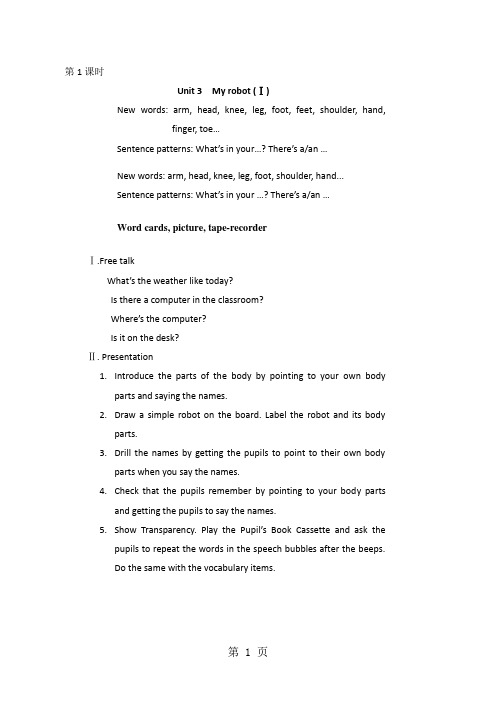
第1课时Unit 3 My robot (Ⅰ)New words: arm, head, knee, leg, foot, feet, shoulder, hand,finger, toe…Sentence patterns: What’s in your…? There’s a/an …New words: arm, head, knee, leg, foot, shoulder, hand...Sentence patterns: What’s in your …? There’s a/an …Word cards, picture, tape-recorderⅠ.Free talkWhat’s the weather like today?Is there a computer in the classroom?Where’s the computer?Is it on the desk?Ⅱ. Presentation1.Introduce the parts of the body by pointing to your own bodyparts and saying the names.2.Draw a simple robot on the board. Label the robot and its bodyparts.3.Drill the names by getting the pupils to point to their own bodyparts when you say the names.4.Check that the pupils remember by pointing to your body partsand getting the pupils to say the names.5.Show Transparency. Play the Pupil’s Book Cassette and ask thepupils to repeat the words in the speech bubbles after the beeps.Do the same with the vocabulary items.Ⅲ. Practice1. Show Transparency. Show the robots on the shelf above the man’shead. Ask What’s this? Encourage the pupils to answer It’s a robot.2. Point to the box. Tell them that pieces of Tim’s robot are in the box.3. Read the speech bubbles. Get the pupils to point to the correctbody parts in Tim’s box.4. Point to the body parts or say their names and get the pupils to askIs there a …?5. Divide the class into two halves. Point to or say the names of thebody parts. Tell half the class to ask the question Is there a …? Tell the other half to replay Yes, there is./No, there isn’t. Try to catch the class out by sometimes saying words like a car, a kite, a doll, etc.exchange the roles so half the other half of the class become the questions.1.Copybook 92.Workbook 113.Write the newwords on thenotebook.Unit3 My robotNew words(picture cards) What’s in your bag? There’s a /an…Is there a/an…1)Revision: eyes, nose, ears, mouth, fingers 2)Supplement:face, body, neck, toes.3)All the words presents in a picture of a man with labels. singing the song with motions, playinga game, and drawing enable pupils memorize all the words.第2课时Unit 3 My robot (Ⅱ)New words: big/small, long/short …Sentence patterns: It has …New words: big/small, long/short …Sentence patterns: It has …Word cards, picture cards, tape-recorderⅠ. GreetingⅡ. Presentation1.Draw two pictures of the same body part on the board. Make onebig and one small. Point to and talk about the pictures, saying, e.g.This is a big head. This is a small…2.Now draw two contrasting robots, i.e. one has a big head and theother has a small head etc. Talk about the robots, for example, Look at this robot. It has a big head. Look at this robot. It has a small head.3.Point to the robots’ arms or legs. Count them. Tell the pupils thereare two. Remind them to say and write the ‘s’ at the end of plural nouns. Write on the board, two arms, two legs. Say it has two arms. It has two legs. Point out the plural of foot (feet).4.Revise the adjectives long and short by pointing to the arms andlegs of the two robots. Make sentences like It has long arms. It has short legs.5.Point to the different body parts and prompt the pupils to makesimilar sentences. Prompt them by giving the adjective and then the name of the body part if necessary.Ⅲ. Practice1.(Book open) Play the Pupil’s Book Cassette. The pupils listen andfollow in their books.2.Help the pupil’s to complete the sentences about the otherrobots in picture3 and picture4.IV. Guessing game.1. Describe one of the robots on the page. Describe the robots inpictures 1 and 2 by using a different sentence order from the one in the book. Get the pupils to say the number of the picture for the robot you are describing.2. Then when I make a sentence describing a body part, Ss shouldpoint to the body part and make a gesture to fit the description.1.Copybook 102.Workbook 123.Write the sentences we learned today.Unit 3 My robotLook at my robot.It has a big head.It has long arms.It has short legs.It has big knees and big feet.More pictures should be given to practise, not only the robot, but the bears or the doll, even pictures of a man.Revision: fat/thin, tall/short, big/small, long/ short第3课时Unit 3 My robot (Ⅲ)The words: dear, sir, great, again…The sentence patterns of “Look at…?”, “It has …”Sentence patterns “Look at…?”“It has…”Sentence patterns “Look at…?”“It has…”Picture cards, tape-recorderⅠ. GreetingHow are you?What’s the weather like today?Do you like it?Ⅱ. Presentation1.Point to the characters in the pictures and read their speechbubbles aloud. Ask the pupils to point to the speech bubbles as you read them.2.Play the Pupil’s Book Cassette for the pupils and ask them to saythe sentences after the cassette.3.Ask the pupils to come up and play the roles of Koko, Pat and therobot scientist.4.Ask the pupils to role-play the story in groups of three and readthe characters’ speech bubbles. Some groups may like to come out to the front and act the story.e Storycsrds to revise sequence and language of the story.III. Do Part D.( Circle the correct words. P16)1.Ask the pupils to read the story again. I read the words in thespeech bubbles with the pupils.2.Demonstrate how to circle the correct choice in the first sentenceas an example.e Transparency to check the answers.Ⅳ. Do exercises in the Workbook(P.13)Ask the pupils to look at the pictures and listen to the Workbook Cassette.Ask the pupils to tick the correct pictures according to what they hear on the tape.Let the pupils listen again, I check their answers.Tapescript:1.I like that robot. It has long legs. It can run.2.This robot has one arm. It has one shoulder. It has one l eg. …1. Copybook 112. Listen to the tape to review PartC.Unit 3 My robot Oh, dear! It has no head.I can help you.Thank you, sir.That’s great.Ask pupils listen to the record and draw the robots before read the story may vary the practice and make more fun.第4课时Unit 3 My robot (Ⅳ)The pronunciation of “ea” in the following words: head, bread, ready, steadyPronunciation “ea” in the words: head, bread, ready…Pronunciation “ea” in the words: head, bread, ready…Picture cards, word cards, tape-recorderⅠ. GreetingWhat’s on your chair?Is there a bag on your chair?What’s in your school bag?There’s a book/a pencil/a pen…What’s in your pencil case?There’s a pen/a pencil…Ⅱ. PresentationPlay the Pupil’s Book Cassette and ask the pupils to listen to the sound and the words. Point out the spelling of this sound. It is important that the pupils realize the vowel sound is spelt with two letters. This is a short vowel sound.Say the words slowly and clearly. Check that the pupils are saying the sounds correctly.Point to the pictures and check that the pupils can say the words without your model.Play the pupil’s Book Cassette again. Ask the pupils to point to the waiter’s head and bread. Get Ss to say the rhyme. Ⅳ. Workbook ( P14 )1.Ask the pupils to look at the first part of the page andlisten to the Workbook Cassette. They need to draw a line to the correct car according to the sound they hear on the tape.Tapescript and answers: ea (head)2.Ask the pupils to look at the second part of the page. Tellthem to look at the pictures and fill in the blanks in the sentences for the pictures.Answers: I have a robot. It has big hands. It has small feet.I have a robot, too. It has long legs. It has shortarms.V. Summary: Sum up the main point.1. Copybook 122. Workbook 143. Write what welearnedtoday.Unit3 My robothead bread eaready steady第5课时Unit 3 My robot (Ⅴ)Get Ss to be more familiar with the words and the sentence patterns “ what’s in your …”“There’s a/an …”“It has…”…words and the sentence patterns “It has…”words and the sentence patterns “It has…”Word cards, pictures and tape-recorderⅠ. GreetingWhat’s the weather like today?It’s …Do you like it?Yes, I do. /No, I don’t.What’s in your school bag?Is there a pencil case?…Ⅱ. Word revision1.Draw a picture of a body, ask the pupils to say the namesof the body part. (arm, head, knee, leg, foot, shoulder, hand).2.Choose some students to spell the words, and choosesome able students, make sentences with words.Ⅲ. Presentation ( F. Look and do. P.17)1.Show the pupils the body parts of the robot on page 62.Tell them to cut out a head, legs and arms. Show them the body and have them cut it out.2.Tell the pupils to paste the body parts they have chosenfor their robot onto a piece of paper. Tell them to describe their robot by filling in the blanks on the bottom left of page 17.3.Tell the pupils to work in pairs. Ask them to take turns toshow their friend their robot and talk about it. They then write sentences about their friend’s robot.Ⅳ. More to doThe more able pupils can tell their friends what their robot can do, eg. It can run. It can jump. It can fly.Ⅴ. Workbook. (P.15)1.Ask the pupils to look at the pictures at the top of thepage and read the sentences at the bottom of the page.2.Then tell them to match the pictures and the sentencesby writing the correct letters in the circles.Answers: 1. c 2. a 3. b 4.d1. Review thewords2. Review whatwe learnedtoday.Unit 3 My robot My robot has a …head. It has …shoulders.It has …arms.It has…hands.It can… …第6课时Unit 3 My robot (Ⅵ)Consolidate all the new words and sentence patterns of Unit 3Sing the songsNew words and sentence patternsSentence patternsWord cards, picture cards, tape-recorderⅠ. Free talkWhat’s on the desk?Is there a book?Are there any chalks?What does the boy look like?He has …. He has…. He has ….What does the girl look like?She’s pretty. She has…Ⅱ. Revision1.Revision the new wordsarm, head, knee, leg, foot(foot), shoulder, hand, oh, dear great, now, again big small long short tall…2.Review sentence patterns.What’s in your box?There’s an arm.Is there a head?Yes, there is.Look at my robot. It has a big head.It has long arms. It has short legs…….Ⅲ. Sing and playPlay the pupil’s Book Cassette for the pupils to listen to the song. Show the pupils how to do the different actions shown in the pictures. Play the cassette again and encourage the pupils to join in with the words.Ⅳ. More to doYou can sing the song and miss out the words for the body parts one by one. In the first verse, miss out the word ‘head’and just point to it but sing the rest of the words. In the second verse, miss out ‘head and shoulders’while still pointing to them. Continue in this way until the pupils are completely silent and only pointing to their body parts.Ⅴ. SummarySum up the main points.1.Review thewords.2.Recite PartA,B.Unit 3 My robot He has big eyes. She has small ears. It has fat arms.It has thin legs.。
香港培生朗文2A第3单元
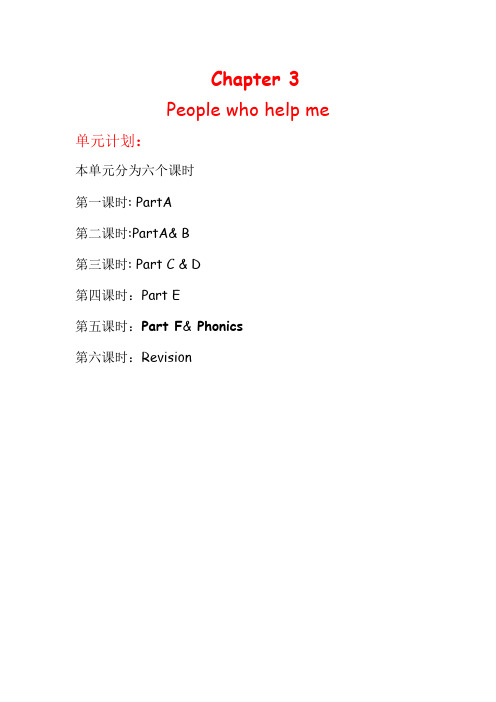
Chapter 3People who help me 单元计划:本单元分为六个课时第一课时: PartA第二课时:PartA& B第三课时: Part C & D第四课时:Part E第五课时:Part F& Phonics第六课时:RevisionChapter 3People who help meTeaching Aims:Aims of the knowledge:1.The theme of this chapter is people who help us in our everyday life.2.Pupils learn to talk about people who help them. They talk about these people’s identity, describe them and tell if they like them.3.They use the information to write a Thank-you note to the people who help them.4. To introduce pupils to the interrogative pronoun who and the personal pronouns him and her.5. Interrogative pronouns: who6. Personal pronouns: her himAuxiliary verbs: Do you like him?Adjectives: she’s kind.VocabularyCaretaker, Chinese, driver,Friendly, helpful, her(pron),Maths, Mr, Mrs, Music, PE,unfriendly, unhelpful,unkindReceptive: again, hurry, ok, PrefectPhonicsr-controlled vowel: er /ə /Aims of the abilities:1.Listening : Locate specific information . Recognise pronounreferences.2.Speaking : Provide information in response to factual or yes/no questions.3.Reading : Locate specific information .4.Writing : Provide personal ideas and information based ona model.Aims of the emotion:1.Develop participatory, cooperative , love and caring othersin daily life .2.Appreciative with respect for others.Key points:1.Pupils learn to talk about people who help them. Theytalk about these people’s identity, describe them and tell if they like them.2.They use the information to write a Thank-you note tothe people who help them.3.To introduce pupils to the interrogative pronoun who andthe personal pronouns him and her.Difficult points:1 . To introduce pupils to the interrogative pronounwho and the personal pronouns him and her.2.Pupils learn to talk about people who help them.They talk about these people’s identity, describe them and tell if they like them.Process and method:提出问题法(Question ---Answer activity)独立完成法(Individuals)小组合作法(Group work)直接教学法(Direct Method)互动式教学法(Interactive Learning)情境教学法(Situational Language Teaching)听说教学法(Audio-Lingual Method)肢体反应教学法(Total Physical Response)沟通式教学法(Communicative Language Teaching)自然教学法(Natural Approach)字母拼读法(Phonics)歌谣韵文教学法(Songs & Rhymes Teaching)电脑辅助教学法(CAI)The 1st PeriodTeaching aims:Aims of the knowledge:1. To introduce pupils to the interrogative pronoun who and the personal pronouns him and her.2.To converse about feelings, interests and experiences .3.To obtain and provide objects and information in simple classroom situations and through activities such as interactive games and role-playAims of the abilities:1. Use simple sentences to communicate with others.2. Pupils learn to talk about people who help them.They talk about these people’s identity, describe them and tell if they like them.3. To establish and maintain relationships and routines incarring out classroom activities.Aims of the emotion:1. Appreciative with respect for others.Key points:1.To introduce pupils to the interrogative pronounwho and the personal pronouns him and her.2.Let the Ss know Who’s their teacher ?3.Let the Ss know their school timetable . Difficult points:1. To introduce pupils to the interrogative pronoun who and the personal pronouns him and her.Resources checklist:Flash card , CD , super E-bookB.D:反思:第一节课的课程设置为讲周一的课表,我把各位代课老师的照片制作成了PPT,很能激发学生的兴趣。
美国Wonders、香港朗文、上海牛津:小学英语教材到底能差出几个维度?

美国Wonders、香港朗文、上海牛津:小学英语教材到底能差出几个维度?美国Wonders、香港朗文、上海牛津:小学英语教材到底能差出几个维度?前段时间,某公众号发出了一篇“免费领取美国加州原版教材pdf/视频”的文章,被多个家长转载到EU教育群,点击进去,阅读量近2万。
很多家长下载后,发现这套教材精深宏大、却反而不知道该如何下手,而众多教育类网站,也有推荐或不推荐的各种点评。
那么问题来了:市场上五花八门的小学英语教材区别到底是什么?哪些更适合孩子循序渐进的学习?教材之间的水平标准又差出来多少?本文,EU就将国内英语教育市场(含学校内与培训班)的现状与教材选用做梳理与对比,让家长们更清楚的了解孩子们英语学习的状态与相对层次。
开篇的话在一年级一班的课堂上,30个孩子,面对自己入学后的第一节英语课,有的一脸懵圈、老师一节课怎么讲这么多东西,有的慵懒无语,都升小学了,怎么还在教这些无聊的东西,而老师,面对30个层次不一的孩子,就高也不行,就低也不行,一节课,怎么把握,都有上下一批照顾不到的孩子。
——这就是现在真实而复杂的英语课教学写照。
一直被作为核心主科的语数外三门课,语文、数学,大家水平差异都不大,唯独英语,30个孩子恨不得能化为30个基础层次,因为幼儿园阶段,有的教,有的不教;有的每班配英语老师,有的几班共用英语老师;有的外教跟班,有的外教一周来两次;差异更明显的是孩子妈们,有的天天坚持亲子阅读,有的从2岁起开始送培训班,有的自己能力不够态度也没所谓,有的则不希望孩子太早学习第二外语。
在这种情况下,孩子的个性化差异体现的极为明显,那么带给老师和家长最大的困扰就是未来的学习应该如何组织才能满足不同的需要。
具体而言,孩子的入学水平如何评估,应该对应使用何种教材,家长对孩子的英语水平层次在学校、在深圳处于什么样的分位,这些问题,并不容易拥有清晰概念。
下面我们就从各校的教材介绍与展示、教材属性与对比研究等几方面做具体说明。
香港朗文2B单词句子及中译英格式之欧阳文创编
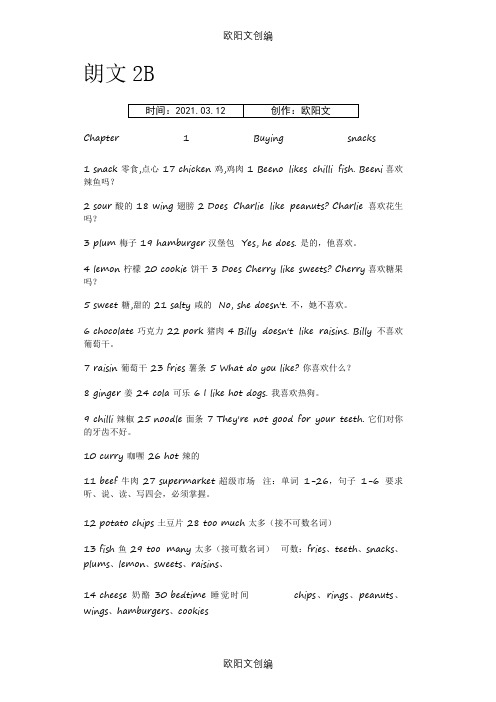
朗文2BChapter 1 Buying snacks 1 snack 零食,点心 17 chicken 鸡,鸡肉 1 Beeno likes chilli fish. Beeni喜欢辣鱼吗?2 sour 酸的 18 wing 翅膀 2 Does Charlie like peanuts? Charlie喜欢花生吗?3 plum 梅子 19 hamburger 汉堡包 Yes, he does. 是的,他喜欢。
4 lemon 柠檬 20 cookie 饼干 3 Does Cherry like sweets? Cherry喜欢糖果吗?5 sweet 糖,甜的 21 salty 咸的 No, she doesn't. 不,她不喜欢。
6 chocolate 巧克力 22 pork 猪肉 4 Billy doesn't like raisins. Billy不喜欢葡萄干。
7 raisin 葡萄干 23 fries 薯条 5 What do you like? 你喜欢什么?8 ginger 姜 24 cola 可乐 6 I like hot dogs. 我喜欢热狗。
9 chilli 辣椒 25 noodle 面条 7 They're not good for your teeth. 它们对你的牙齿不好。
10 curry 咖喱 26 hot 辣的11 beef 牛肉 27 supermarket 超级市场注:单词1-26,句子1-6要求听、说、读、写四会,必须掌握。
12 potato chips 土豆片 28 too much 太多(接不可数名词)13 fish 鱼 29 too many 太多(接可数名词)可数:fries、teeth、snacks、plums、lemon、sweets、raisins、14 cheese 奶酪 30 bedtime 睡觉时间chips、rings、peanuts、wings、hamburgers、cookies15 ring 环形 31 tooth/teeth 牙齿(单数/复数)不可数:chocolate、ginger、curry、beef、16 peanut 花生 32 menu 菜单fish、chicken、pork、cola、noodle Chapter 2 Our favourite food1 favourite 最喜欢的 21 add 添加 1 Is there any butter? 有奶油吗?2 butter 黄油 22 mix 混合 2 Yes, there is. 是的,有。
香港朗文2A Chapter5 - 2B Chapter3 知识点复习
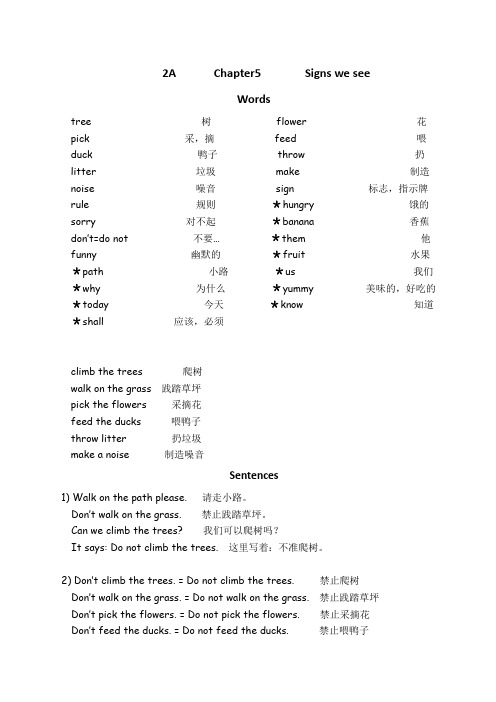
2A Chapter5 Signs we seeWordstree 树flower 花pick 采,摘feed 喂duck 鸭子throw 扔litter 垃圾make 制造noise 噪音sign 标志,指示牌rule 规则*hungry 饿的sorry 对不起*banana 香蕉don’t=do not 不要…*them 他funny 幽默的*fruit 水果*path 小路*us 我们*why 为什么*yummy 美味的,好吃的*today 今天*know 知道*shall 应该,必须climb the trees 爬树walk on the grass 践踏草坪pick the flowers 采摘花feed the ducks 喂鸭子throw litter 扔垃圾make a noise 制造噪音Sentences1) Walk on the path please. 请走小路。
Don’t walk on the grass. 禁止践踏草坪。
Can we climb the trees? 我们可以爬树吗?It says: Do not climb the trees. 这里写着:不准爬树。
2) Don’t climb the trees. = Do not climb the trees. 禁止爬树Don’t walk on the grass. = Do not walk on the grass. 禁止践踏草坪Don’t pick the flowers. = Do not pick the flowers. 禁止采摘花Don’t feed the ducks. = Do not feed the ducks. 禁止喂鸭子Don’t throw litter. = Do not throw litter. 禁止扔垃圾Don’t make a noise. = Do not make a noise. 禁止制造噪音3)A: Can we climb the trees? 我们能爬树吗?B: No, we can’t. Look at the sign. It says: Do not climb the trees.不,我们不能爬树。
香港朗文2A-二年级阶段检测试题
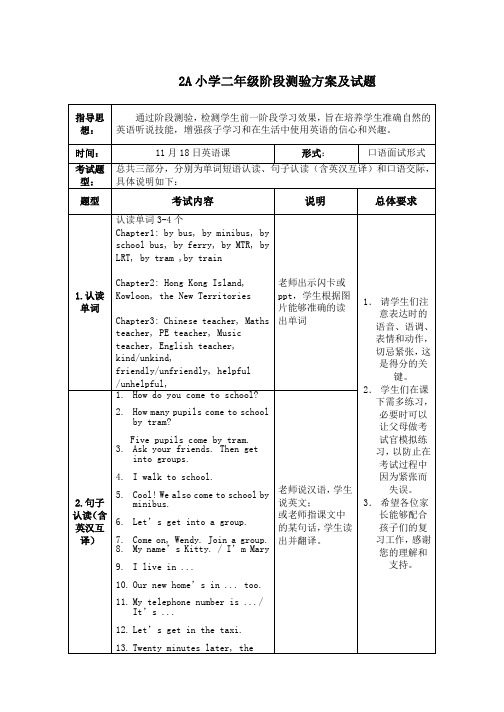
老师出示闪卡或ppt,学生根据图片能够准确的读出单词
2.How many pupils come to school by tram?
Five pupils come by tram.
3.Ask your friends. Then get into groups.
4.I walk to school.
5.Cool! We also come to school by minibus.
6.Let’s get into a group.
e on, Wendy. Join a group.
8.My name’s Kitty. / I’m Mary
9.I live in ...
10.Our new home’s in ... too.
11.My telephone number is .../ It’s ...
(3)T:What’s your telephone number?
S:It’s .../ My telephone number is...
(4)T:Bye-bye.S:See you. / Bye-bye.
(5)T:How old are you?S:I’m...
(6)T:Who’s your PE/Chinese /Maths/English/Music/Art teacher?
1.请学生们注意表达时的语音、语调、表情和动作,切忌紧张,这是得分的关键。
香港朗文小学英语教材教学内容
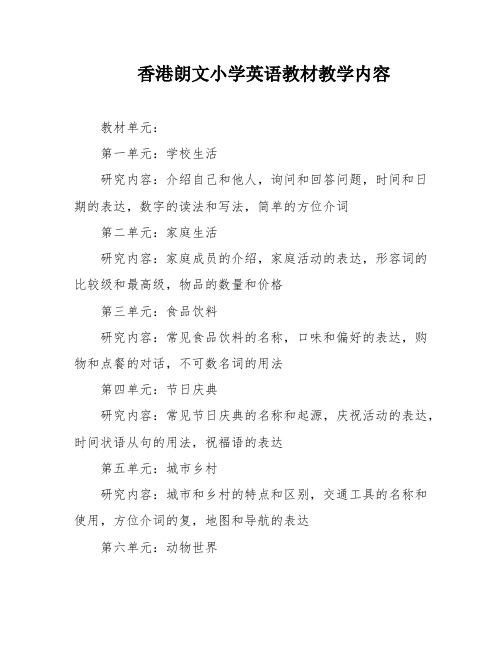
香港朗文小学英语教材教学内容教材单元:第一单元:学校生活研究内容:介绍自己和他人,询问和回答问题,时间和日期的表达,数字的读法和写法,简单的方位介词第二单元:家庭生活研究内容:家庭成员的介绍,家庭活动的表达,形容词的比较级和最高级,物品的数量和价格第三单元:食品饮料研究内容:常见食品饮料的名称,口味和偏好的表达,购物和点餐的对话,不可数名词的用法第四单元:节日庆典研究内容:常见节日庆典的名称和起源,庆祝活动的表达,时间状语从句的用法,祝福语的表达第五单元:城市乡村研究内容:城市和乡村的特点和区别,交通工具的名称和使用,方位介词的复,地图和导航的表达第六单元:动物世界研究内容:常见动物的名称和特征,动物分类和栖息地的介绍,形容词的修饰,比较句型的用法第七单元:自然环境研究内容:自然环境的描述和特点,天气和季节的表达,常见自然灾害的名称和预防措施,情态动词的用法教材单元:第一单元:研究内容:研究日常家务劳动的动词短语。
研究第三人称单数的一般疑问句和陈述句。
研究字母组合ay的发音。
研究表示行为规范的单词。
研究星期的全称和缩写形式。
研究字母组合th的清辅音发音。
研究交通工具名称。
研究用不同的特殊疑问词提问。
研究字母组合tr / dr的发音。
研究职业名称。
研究询问和表达家庭成员的职业。
研究字母组合th的浊辅音发音。
研究关于课外活动的动词短语。
研究询问和表达日常的活动安排。
研究字母组合cr / gr的发音。
研究一天中经历的不同活动的动词词组。
研究询问他人作息与活动的时间安排。
研究字母组合or的发音,并对比元音o的发音。
研究与季节和天气相关的形容词。
研究更多的衣物名称。
研究字母组合oa / ow的发音。
语法知识:研究一般现在时和现在进行时的区别。
第二单元:研究内容:研究第三人称单数的肯定句和否定句。
研究第三人称单数动词的变化规则。
复where / how / what等特殊疑词的用法。
区分介词on,in,by的用法。
香港朗文1-6年级单词汇总之欧阳文创编
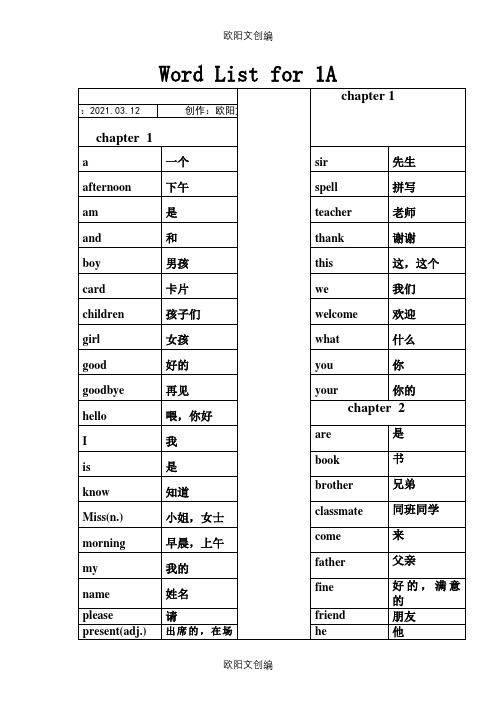
club
俱乐部
timetable
时间表
heavy
重的
twenty-five
二十五
light
轻
magazine
杂志
Word List for 2B
chapter 5
chapter 6
oval
椭圆的
model
模型
round
圆的
Monday
星期一
splash
溅起
of course
rabbit
兔子
eighteen
十八
seed
种子
elephant
大象
these
这些
eleven
十一
those
那些
fifteen
十五
Word List for 1B
chapter 3
chapter 3
fly
飞
thirteen
十三
fourteen
十四
tree
树
grass
草地
twelve
十二
grey
灰色
twenty
制作
his
他的
Mum
妈妈
jacket
夹克
photo
相片
jeans
牛仔裤
plane
飞机
jumper
毛衣
ride
骑
off
脱掉
today
今天
purple
紫色
Word List for 1B
chapter 6
shirt
衬衣
shoe
鞋子
shorts
短裤
最新香港朗文小学英语教材Primary-Longman-Express3A重点词汇与句子

[ˈkæmpiŋ]
露营
Hale Waihona Puke shout[ʃaʊt]
呼喊
tent
[tɛnt]
帐篷
piglet
[ˈpɪɡlɪt]
仔猪
pig pen
猪圈
goat
[goʊt]
山羊
clue
[klu]
线索
detail
[dɪˈteɪl]
细节
Where do you want to go? 你想去哪里?
I want to go to the beach. 我想去海滩。
[tʃɛk]
revise
[rɪˈvaɪz]
修改
improve
[ɪmˈpruv]
model
[ˈmɑ:dl]
模型
robot
[ˈroʊbɑ:t]
manga
['mæŋɡə]
漫画
comic
[ˈkɑ:mɪk]
ski
[ski]
滑雪
cartoon
[kɑ:rˈtu:n]
Philippines
[ˌfɪlə'pi:nz] 菲律宾 guitar
论坛 个人的 说唱 检查 改善 机器人 漫画 卡通 吉他 手套 闲聊 拼图
单词
1 2 3 4 5 6
advertisement expression
第五课
[ˌæ dvərˈtaɪzmənt]
广告
[ɪkˈsprɛʃən] 表达
coupon price
[ˈku:pɑ:n] [praɪs]
优惠券 价格
phrase
exhibition
[ˌɛksəˈbɪʃən] 展览
concert
Chapter3 Knowing me(课件)新版香港朗文英语二年级下册
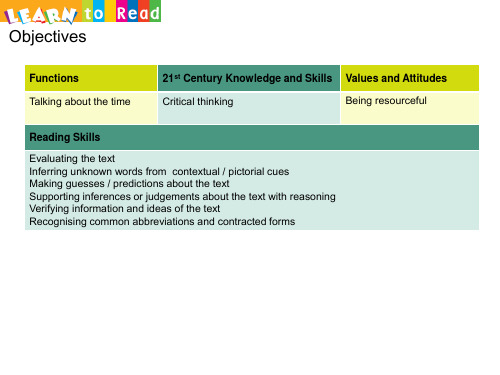
Overview
Reading Pre-reading First reading Second reading
Post-reading
– Doing a picture walk
– Shared reading
– Reading aloud – Activity 1: Assessment for learning
Let’s look at some pictures!
Doing a picture walk
baby birds
Mother Bird
Which one is Mother Bird?
How about these three birds?
Doing a picture walk
Do you think the cat and the birds are friends?
1:15 lunch 4:45 snack 6:30 dinner 10:00 go to bed
It’s time for lunch. What time is it?
Round 1
Activity 3
Number 3, wake up!
in the morning
Round 1
Activity 3
Number 4, wake up!
It’s nine o’clock
Round 1
Activity 3
It’s nine o’clock in the morning. It’s time to wake up.
– Activity 2: Readers’ theatre – Activity 3: Let’s work out the sentences! – Activity 4: What time is it?
香港朗文小学英语教材
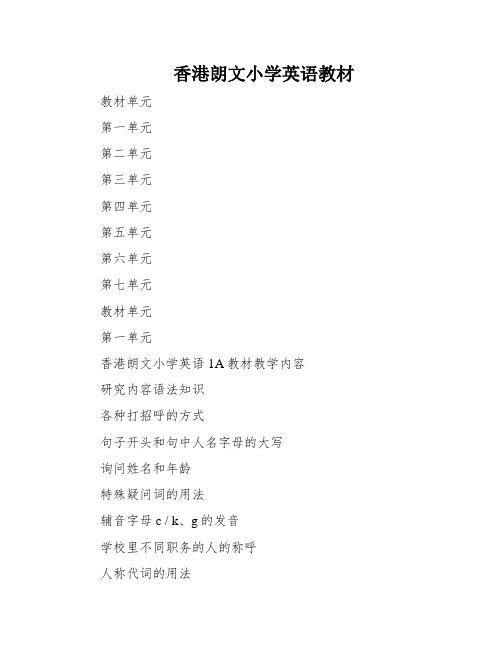
香港朗文小学英语教材教材单元第一单元第二单元第三单元第四单元第五单元第六单元第七单元教材单元第一单元香港朗文小学英语1A教材教学内容研究内容语法知识各种打招呼的方式句子开头和句中人名字母的大写询问姓名和年龄特殊疑问词的用法辅音字母c / k、g的发音学校里不同职务的人的称呼人称代词的用法向他人介绍自己的朋友或老师辅is / am / are的用法音字母m、n的发音研究用品的名称名词的单复数形式描述自己和他人文具用品的数量have / has的用法辅音字母b、p的发音校内设施的名称指令性语言听懂并正确回应老师的不同指令动词和介词的搭配子音字母d、t的发音身体部位形容词介绍别人并对别人特性举行描述描述词性物主代词的用法元音字母i的短音发音动物名称指示代词this / that表达自己的喜好复数形式XXX的用法元音字母a的短音发音水果称号不定冠词a / an的用法11-20的数字There be句型的用法子音字母f、v的发音香港朗文小学英语1B教材教学内容研究内容语法知识常见玩签字称连词and的用法对物品的颜色举行描述It is与They are的用法元音字母e的短音发音复is / are & have / has各类衣服的名称名词所有格询问和表达某物是某人的Is this与Are these的用法字母s以及字母组合sh的发音一般疑问句的肯定和否定回答公园里的动植物和各类设施的名称定冠词the与不定冠词a / an的用法观察并表达物体的位置方位介词in,on,under,near的区别元音字母u的短音发音特殊疑问词where的用法常见动物园里的动物名称特殊疑问词How many的用法询问并回答关于动物的数量代词Some,all的用法子音字母z的发音常见举措及其目前分词体式格局现在进行时态询问并回答某人正在做什么温人称代词辅音字母l、r的发音更多常见动作及其现在分词形式巩固复现在进行时态表达不同人正在做不同的事情复介词辅音字母w和字母组合XXX的发音感觉、感受类及食品饮料类词汇一般疑问句讯问别人的感受并提出建议Let's句型的用法元音字母o的短音发音重难点指数★★★★XXX★★★XXX★★★★★★XXX★★★★★★★★重难点指数★★★★★第二单位★★★★第三单位★★★★第四单位★★★第五单位★★★★★第六单位★★★★★第七单位★★★香港朗文小学英语2A教材教学内容教材单位进修内容常见公家地址的称号祈使句的肯定和否定表达第一单元公共场合标志牌的介绍动词短语字母组合ar的发音产生在公共场所的动词和动词短语第二单元公家场所的行为举止请求介词at,on,in的用法字母组合a_e的发音常见食品称号第三单位辨别可数与不成数名词XXX和字母组合ch的发音可数与不可数名词There be句型一般疑问句以及肯定和否定回答Do you like。
香港朗文综合英语小学二年级英语下册期末试卷

香港朗文综合英语小学二年级英语下册期末试卷香港朗文综合英语小学二年级英语下册期末试卷篇一:苏教版二年级英语下册期末试卷第二学期二年级英语期末试卷听力部分一、选出听到的单词,将序号填在题前的括号内,听一遍。
(10分)( ) ( ) ( ) ( ) ( ) ( ) ( ) ( ) ( ) ( )1. 2. 3. 4. 5. 6. 7. 8 9. 10.A. noA. Chinese A. seven A. nine A. morning A. bed A. puppet A. help A. go to bed A. summerB. on B. Maths B. twelve B. fine B. mango B. bad B. puzzle B. keepB. go home B. someC. one C. Music C. eleven C. lion C. mother C. blue C. panda C. jeepC. at school C. sister二、听录音,选出你所听到的图片,听一遍。
(10分)( ) 1. A B( ) 2. AB( ) 3. A B( ) 4. AB( ) 5. A B( ) 6. AB( ) 7. A B( ) 8. AB( ) 9. A B( ) 10. A B三、听录音,选出你所听到的句子,听两遍。
(10分)( ) ( ) ( ) ( ) ( ) 1. 2. 3. 4. 5. A. What do you like? A. How are you? A. I like monkeys. A. There is a can.A. Do you like summer?B. What do you have? B. How old are you?B. I like this monkey. B. They are cans.B. Do you like spring?四、听录音,给下列句子标序号,听两遍。
深港朗文英语二年级下unit3-4
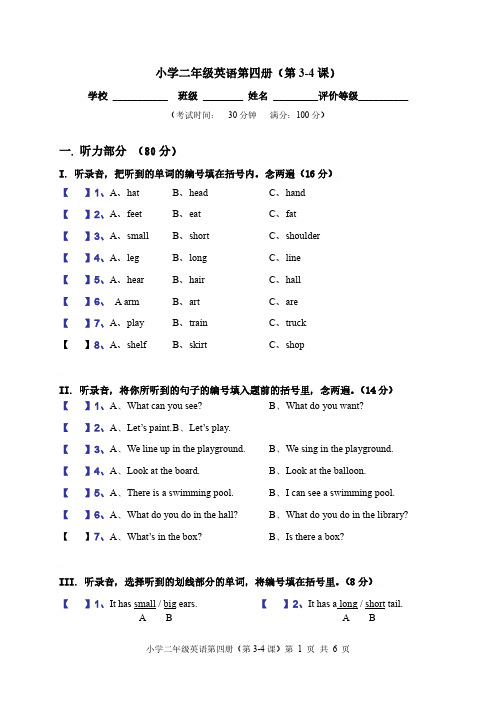
小学二年级英语第四册(第3-4课)学校___________ 班级________ 姓名_________评价等级__________(考试时间:30分钟满分:100分)一. 听力部分(80分)I. 听录音,把听到的单词的编号填在括号内。
念两遍(16分)【】1、A、hat B、head C、hand【】2、A、feet B、eat C、fat【】3、A、small B、short C、shoulder【】4、A、leg B、long C、line【】5、A、hear B、hair C、hall【】6、 A arm B、art C、are【】7、A、play B、train C、truck【】8、A、shelf B、skirt C、shopII. 听录音,将你所听到的句子的编号填入题前的括号里,念两遍。
(14分)【】1、A、What can you see? B、What do you want?【】2、A、Let’s paint. B、Let’s play.【】3、A、We line up in the playground. B、We sing in the playground.【】4、A、Look at the board. B、Look at the balloon.【】5、A、There is a swimming pool. B、I can see a swimming pool.【】6、A、What do you do in the hall? B、What do you do in the library?【】7、A、What’s in the box? B、Is there a box?III. 听录音,选择听到的划线部分的单词,将编号填在括号里。
(8分)【】1、It has small / big ears. 【】2、It has a long / short tail.A B A B【】3、It has big / small legs. 【】4、I can’t draw / paint.A B A BIV. 听录音,根据录音顺序用A,B,C……给下列图片编号。
- 1、下载文档前请自行甄别文档内容的完整性,平台不提供额外的编辑、内容补充、找答案等附加服务。
- 2、"仅部分预览"的文档,不可在线预览部分如存在完整性等问题,可反馈申请退款(可完整预览的文档不适用该条件!)。
- 3、如文档侵犯您的权益,请联系客服反馈,我们会尽快为您处理(人工客服工作时间:9:00-18:30)。
第三课 我的一天
Key Words
关键词
1 wash my face
1 洗脸
2 brush my teeth
2 刷牙
3 have breakfast
3 吃早餐
4 do my homework
4 做作业
5 have a shower
5 洗澡
6 go to bed
6 睡觉
E Beeno正在写信给他的笔友。帮他完成这封信。
Here's an example.
例子。
Dear Momo, My name is Beeno.
亲爱的默默,我的名字是Beeno。
I live on Mars. Do you want to be my pen friend?
我住在火星上。你想成为我的笔友吗?
Mother Bird sees the cat. It is waiting by the nest.
鸟妈妈看见了猫。它正在鸟巢旁边等。
4 I must stop that cat.
4 我必须阻止那只猫。
That night Mother Bird has an idea.
那天晚上鸟妈妈想到一个主意。
例子。
It's time to brush your teeth.
你该刷牙了。
What's the time?
现在几点?
It's seven oh five.
现在7点零5分。
Now you try.
现在你来试。
Learn to Read
学着读
C How does Mother Bird look after her babies? Read and find out.
6 It's time to eat the baby birds.
6 吃那些小鸟们时间到了。
Look at that silly cat. It can't catch us. Well done, Mum!
看那只笨猫。它抓不到我们。做得好,妈妈!
Is Mother Bird clever? Why?
5 The next day, the cat reads Mother Bird's timetable.
5 第二天早上,猫看到了鸟妈妈的时间表。
Aha! The baby birds are alone at eleven fifteen toda的。
A What does Tom do every day? Read.
A 汤姆每一天都做些什么?阅读。
1 Tom, it's time to get up and wash your face.
1 汤姆,你该起床洗脸了。
2 What's the time, Mum?
2 妈妈,现在几点了?
3 It's seven o'clock.
Mother Bird and her babies live in a nest in a tree.
鸟妈妈和她的小婴儿住在一棵树上的巢里。
2 Be careful, Mimi! The cat wants to eat you.
2 咪咪,小心一点!那只猫想吃了你。
OK, Mum.
好的,妈妈。
Mother Bird takes good care of her babies.
说这些音标和单词。
i_e
i_e
nine
九
five
五
i
fifteen
十五
fifty
五十
Can you say these words?
你会说这些单词吗?
Tim
提姆
time
时间
Pre-task Activity
作业前活动
E Beeno is writing a letter to his pen friend. Help him finish it.
鸟妈妈聪明吗?为什么?
D Draw lines.
D 画线。
Here's an example.
例子。
1 The baby birds have a flying lesson at 9:30 a.m.
1 小鸟们在早上9点30分上飞行课。
Now you try.
现在你来试。
Phonics
语音
Say the sounds and the words.
3 现在七点。
4 It's time to have breakfast, Tom.
4 汤姆,该吃早餐了。
5 What's the time?
5 现在几点?
6 It's seven fifteen.
6 现在7点15分.
7 Tom! It's time to go to school.
7 汤姆!你该上学了。
C 鸟妈妈是怎么样照顾她的小婴儿的?阅读,找出答案。
1 What time is it, Mum?
1 妈妈,现在几点了?
It's nine thirty in the morning. It's time to have your flying lesson.
现在是早上9点30分。你们练习飞行的上课时间到了。
8 What's the time ?
8 现在几点?
9 It's half past seven.
9 现在7点30分。
B Act Tom and his mother. Talk about the other activities.
B 扮演汤姆和他的妈妈。说说其他的活动。
Here's an example.
Let me tell you what I do every day.
让我告诉你我每一天所做的事情。
I get up at three o'clock in the morning.
我在凌晨3点起床。
I go to school by spaceship at 4:45.
我在凌晨4点45分坐太空船去上学。
鸟妈妈很仔细地照顾她的小婴儿。
3 I'm hungry, Mum. What's the time?
3 妈妈,我饿了。现在几点了?
It's one twenty in the afternoon. It's time to have our lunch. Come along.
现在是下午1点20分。我们吃午餐的时间到了。跟我来。
Now you try.
现在你来试。
Task
作业
Write a reply to Beeno.
写一封回信给Beeno。
Language Fun
趣味语言
F Draw the times. Play a bingo game.
F 画时间。玩宾果游戏。
